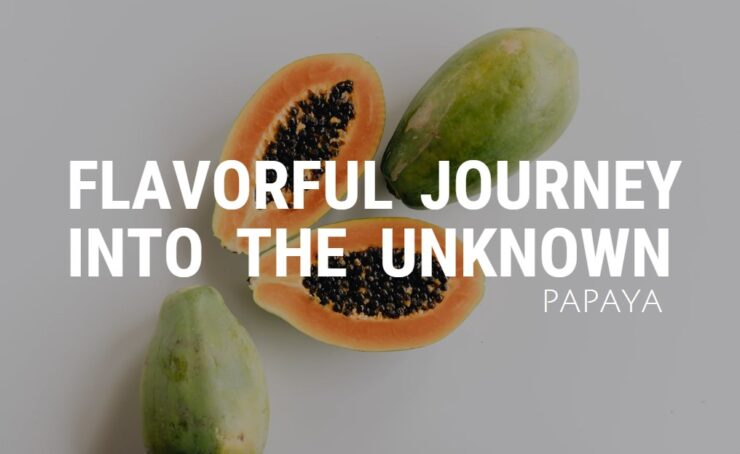Papaya is a yellow-orange fruit that is often consumed for its sweet, mild flavor. Although the texture of papaya can vary from soft and smooth to fibrous and chewy, its flavor profile typically contains a mix of tropical, lightly-sweetened flavors. It has been a staple in countries like India and Mexico for hundreds of years, but its popularity is beginning to grow around the world.
In this guide, we’ll explore the different tastes associated with papaya–from its sweetness to its savory side–as well as how it can be used in cooking and baking. We’ll also discuss nutrition facts about papaya and how it can benefit your health. By the end of this article, you should have a better understanding of what papaya tastes like as well as know how to properly incorporate it into your diet.
Origin of Papaya
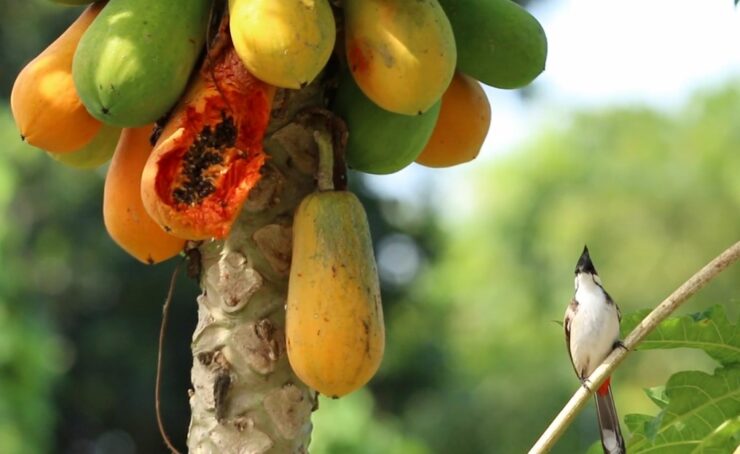
It is a nutrition-rich fruit known as a superfood. It is native to Mexico, Central America, and northern South America but is now cultivated in many parts of the world due to its health benefits. The tree grows up to 8 meters (25 feet) tall and bears yellow-green, pear-shaped fruit that can weigh up to 4 pounds (1.8 kilograms).
Papaya has a sweet and musky flavor with other subtle tastes that range from tropical fruit flavors such as pineapple and citrus to vegetal notes similar to bell pepper or cucumber. Among fruits, it’s often compared most closely with cantaloupe or honeydew melon in terms of taste, texture, and overall appearance.
They can be eaten raw or cooked in some way, such as boiled in syrup or candied.
Nutritional Benefits
It is a sweet and juicy fruit, prized for its health benefits. It is loaded with various vitamins and minerals, including vitamins A and C, riboflavin, thiamin, magnesium, potassium, and folate. It also contains dietary fiber and several antioxidants that can help to protect against harmful free radicals in the body. As a result, it has been associated with various health benefits — from better digestion to improved heart health.
In addition to its beneficial nutrients, papaya is also low in calories; just 100 grams offer only 40 calories of energy. Due to this low-calorie content, it makes a great addition to any weight-loss diet as it provides essential nutrients without extra calories. What’s more — due to its high water content — it helps keep you full for longer periods of time!
Despite these incredible benefits the papaya fruit has high levels of natural sugar that can contribute directly to your daily calorie consumption if consumed in excessive amounts. These sugars should be moderated by eating lower amounts of other sugar-rich foods like candy or processed snacks throughout your day. This fruit also belongs to the Caricaceae family which contains compounds that can upset your stomach if you experience digestive issues or are sensitive to latex or other allergens— so caution should be taken when consuming this powerful superfood!
Different Varieties of Papaya
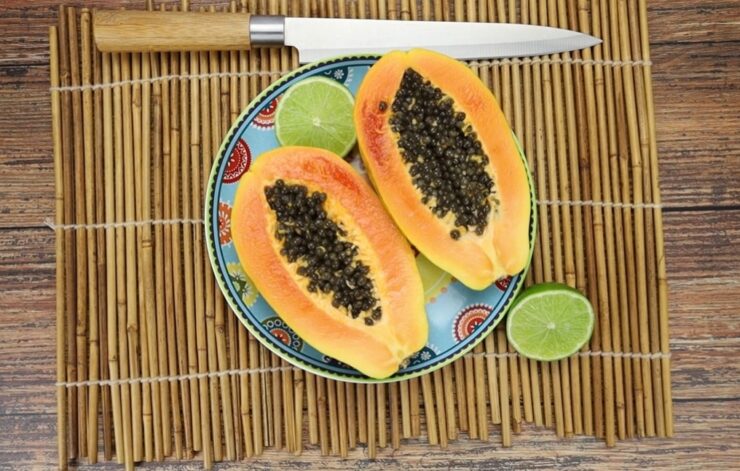
It is a delicious and incredibly versatile fruit, with a sweet and tangy flavor. Depending on the variety, it can range from light yellow to dark orange in color. The different varieties of Papaya offer unique flavors and textures, ranging from sweet and juicy to sour and crunchy.
Let’s explore some of the different varieties of Papaya and what they taste like.
Red Papaya
Red papaya is a smaller variety of the popular yellowish-green fruit. This type is harvested when fully ripe, making it sweeter and juicier than its yellow-green relative, with a much darker coloration and richer flavor. Its skin is glossy and bright red while its flesh is a deep coral color, bursting with sweet-tart tropical flavors.
It offers the same health benefits as other varieties, with an emphasis on digestive health due to its higher levels of enzymes. The fruit is often used in smoothies and shakes for a delicious and refreshing addition to any beverage. It can also be enjoyed as an ingredient in salads, salsas, or sauces for savory dishes.
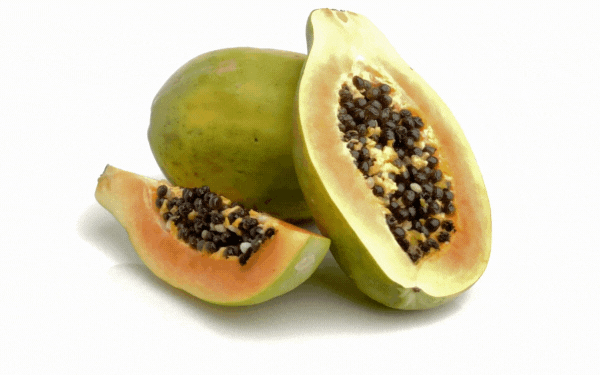
Yellow Papaya
It is a sweet and succulent variety of fruit that has a mild, melon-like flavor. It contains very few seeds, making it ideal for mashing into papaya smoothies or adding to salads. The peel of the yellow variety typically has an orange hue but may range from bright yellow to deeper oranges and red tones. The flesh can range from light yellow to bright orange and it is generally sweeter than green papaya.
It ripens on the countertop in a few days, so it’s best to eat soon after purchase.
Maradol Papaya
Maradol papaya is a large variety of papaya that is approximately 18 to 20 inches long and 7 to 10 inches in diameter. This variety originates from Mexico and has an elongated shape, making it distinct from other varieties of fruit. Its skin is light yellow when ripe, and its interior flesh is bright yellow, pink or orange in color with a sweet flavor profile that is reminiscent of apricots. They are relatively seedless, so the entire fruit can be eaten without much difficulty.
Maradol prefers a hot climate for optimal growth, so it is cultivated primarily in Mexico and Thailand. Since this variety is more adaptable than other varieties, it can be found in markets across the world.
How to Prepare

Preparing it can be a bit tricky, as the skin needs to be removed and the fruit’s seeds may have to be scooped out. However, with the right technique, you can have a delicious and nutritious snack in no time.
Let’s take a look at the steps to prepare papaya.
Diced
Also known as pawpaw and in some parts of the world as mamao, is a tropical fruit that has a delicious sweet and slightly musky flavor. Picking ripe papayas is key for the best flavor. If squeezing the fruit yields slight pressure, then it’s ready to eat. To prepare diced papaya, all you need are a few simple ingredients.
Start by washing your papaya before slicing it in half lengthwise with a sharp knife.
Next, scoop out the seeds on each half with a spoon. Dice the papaya into cubes or slices of your desired size. You may want to delicately peel the skin of each half by running your knife along its exterior edge first before dicing. Once done dicing, transfer them into a bowl before adding additional seasoning or topping ingredients such as honey, yogurt or some orange juice or lime juice if preferred.
For an extra kick of flavor, consider sprinkling over crushed garlic and/or dried chili peppers for an added zestiness to your dish! Enjoy it either plain as is or with any additional seasoning you choose; it’s sure to be a delicious snack full of taste and nutritional value!
Smoothie
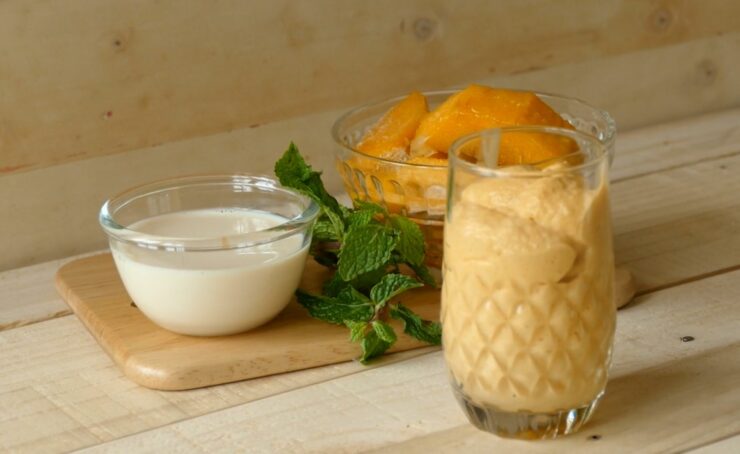
If you love the taste of papaya, a delicious way to enjoy it is with a papaya smoothie. One large smoothie will provide you with large amounts of vitamins A and C, dietary fiber, and potassium.
Start by peeling and seeding the papaya, then chopping it into smaller pieces. Place the pieces into a blender with other ingredients such as plain yogurt, ice, honey, or any other fruit that you might prefer. Blend all of the ingredients until they form a thick liquid. Serve cold in glasses and enjoy!
Salad
It is a colorful and refreshing salad dressed in citrus, garlic, and chili dressing. Since it goes well with most things, it’s the perfect accompaniment to other dishes or can be served as a light meal in itself. It is high in antioxidants and full of vitamins, minerals and fiber. It has an exceptionally sweet flavor and is one of the few fruits that can actually be eaten raw.
To prepare this dish: Start by selecting your papaya if you haven’t already bought it pre-cut. Use papaya that gives slightly when pressed but isn’t overly ripe or unripe – you want the texture to come through even after cooking. Peel it using a sharp knife such as a vegetable peeler and cut it into thin slices and set aside. Prepare your dressing by combining orange juice, lime juice, brown sugar, garlic clove minced and extra virgin olive oil then season with sea salt and freshly cracked pepper to taste.
Arrange the sliced papaya onto a plate or bowl of your choice then spoon over some of your prepared dressing – don’t forget to save some for drizzling over before serving! Finally, sprinkle over some chopped chili (optional) for added spice if desired and serve cold or at room temperature for an amazing taste sensation! Enjoy!
Taste of Papaya

It is a highly sought-after fruit for its unique taste and texture. It has a soft and buttery texture, with a subtle sweetness that is sometimes compared to a mix of mango and pear. Papaya is a popular fruit around the world and is often used in smoothies, salads, desserts, and other dishes.
Sweetness
It is a deliciously sweet and juicy fruit with a unique flavor that combines several familiar tastes. Its taste has been described to be similar to that of mango and cantaloupe, with notes of honeydew melon, passion fruit and even banana.
When ripe, the flesh of it is soft, fragrant and sweet. Its texture is surprisingly smooth for juicy fruit. If you’ve ever had a papaya milkshake or smoothie then you’ll be familiar with its creamy texture.
The blend of flavors makes papaya a fantastic addition to all sorts of dishes like salads, salsas and desserts. Its sweetness works especially well when combined with other spices like ginger or chili and it makes an excellent addition to juices or other drinks.
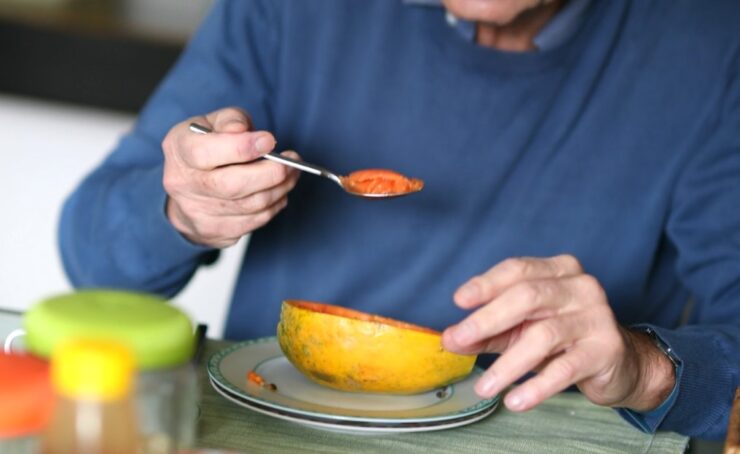
Tartness
The taste of it can vary depending on how ripe the fruit is. Ripe papayas are softer, sweeter and juicier with a smooth, creamy texture and a subtle hint of tartness. Unripe ones have a slightly tart flavor with a crisp texture.
It also contains numerous vitamins and minerals such as vitamin C, folate and potassium, making it an excellent choice for those looking to incorporate more nutritious options into their diet.
Texture
The texture of papaya depends on its ripeness; as it ripens, it becomes softer and sweeter. It is generally quite soft when ripe, making it a great choice for adding to smoothies or slicing into a salad. It also has small black seeds that are edible, though some people choose to remove them before eating the fruit.
Raw papaya has a juicy texture, similar to a cantaloupe or mango. Its flavor can be described as earthy and sweet with hints of melon and citrus. As the fruit ripens, the earthy flavors are replaced with more sweetness, becoming less tart and more mellow.
The skin can also be eaten; when ripe it will turn yellow-orange with splashes of pink on its smooth exterior. Be sure to wash thoroughly before eating!
FAQs
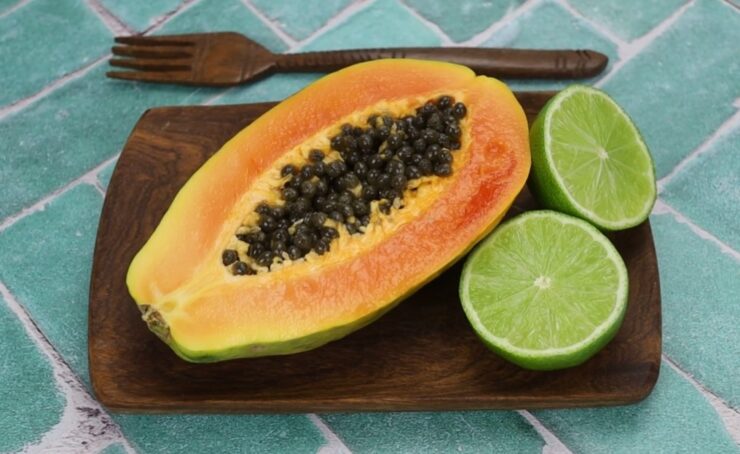
Can you eat papaya skin?
Skin is not typically eaten as it can be bitter and tough.
How can you use papaya in recipes?
It can be used in smoothies, salads, salsas, and as a topping for yogurt or ice cream.
Can papaya be eaten by people with allergies?
People with latex allergies may experience an allergic reaction to it as it contains a similar protein.
Can papaya be eaten by pregnant women?
It should be eaten in moderation by pregnant women as it contains enzymes that can induce labor.
Can papaya be eaten by people with diabetes?
It is a good fruit option for people with diabetes as it has a low glycemic index and is high in fiber.
Can papaya be eaten by people with digestive issues?
The papain enzyme in it can aid in digestion, making it a good option for people with digestive issues.
Where can you find papaya?
It can be found in most grocery stores and at farmers’ markets, especially in tropical regions.
Conclusion
In conclusion, it can be a refreshing and flavorful addition to any meal. Its gentle sweetness and tropical aroma make it a popular fruit for many. Its unusual flavor is usually described as having hints of honey or pear, with an overall sweet-tart taste similar to a mango or mandarin orange.
So the next time you want some tropical flavor added to your meal, reach for papaya!

